Spring Riot is the name Cloud Gate Dancer Theatre (雲門舞集) founder Lin Hwai-min (林懷民) chose for his second company's spring tour this year. It's an aptly chosen title: The four-piece show is a riot of talent, from the choreographers to the dancers to the costume design.
But the title was chosen before anyone could have had an inkling of what a calamitous riot this spring would turn out to be for Lin and his two companies because of the devastating fire that destroyed their Bali Township (八里) home on Feb. 11, forcing them into makeshift accommodations and leaving them scrambling to recreate the costumes, props and other materials needed for their tours.
The companies have rallied admirably and Cloud Gate 2 is ready for its opening night on March 26 in Taipei.

PHOTO: CHIANG YING-YING, AP
Spring Riot's four works are each unique in their own right. Put together they make for a memorable program that showcases Cloud Gate 2's past, present and future.
The program begins with Cocoon (羽化), a piece by the late Lo Man-fei (羅曼菲), who founded the troupe in 1999 to foster young choreographers and dancers. She choreographed the piece in 1987 for the dance department at the National Institute of the Arts (now the Taipei National University of the Arts, TNUA) and then revived it for Cloud Gate Dance Theatre in 1994. Created when Lo was 32, the work explores the often-complicated interactions between men and women and is set to the music of Philip Glass.
In a telephone interview earlier this month, Lin said he had chosen to revive Cocoon for CG2 because it was a reminder of Lo's talent and an excellent example of minimalism. A good piece that holds its own, he said.
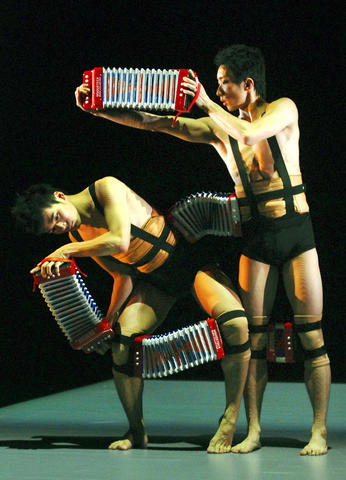
PHOTO: CHIANG YING-YING, AP
"It's very simple, very lyrical, very structured, with simple props. Very pure, something we don't see among young choreographers today. It was an early work [of Lo's] in the 1980s, [when there was] the last trace of simplicity in Taiwan society before all the LV [craze for designer labels] came in and politics," Lin said.
The second piece, Change (變), is by one of the young choreographers that Lo mentored, former Cloud Gate dancer Cheng Tsung-lung (鄭宗龍), who has gained attention both at home and abroad in recent years. Lin included Cheng in the Novel Hall Dance series last May, where he performed Tete-beche, the duet that won him the bronze medal at the First International Choreography Competition in Ludwigshafen, Germany, in 2006.
CG2 performed Cheng's light-hearted A Dignified Joke in their spring 2006 shows. But Change is a change of pace from Cheng's previous works in terms of mood, tempo and technical challenge. It's set to Terry Riley's Keyboard Study 2, a score that with its harmonic repetitions can verge toward the monotonous, but serves to focus attention on the dancers' movements, which is what Cheng wanted.
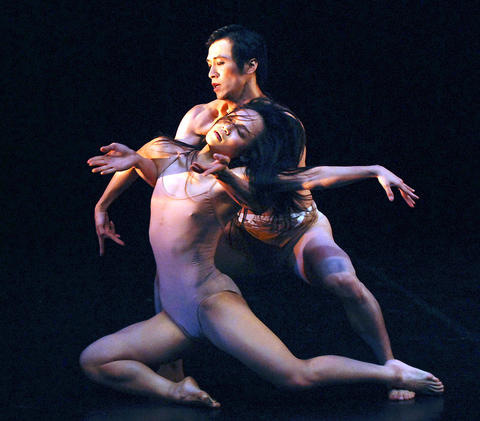
PHOTO: CHIANG YING-YING, AP
"I've been feeling I'm going to change - not just my choreography, in my head, but I don't know when or in what direction, so at this moment I am just focused on the body - not emotion, not more story - just the body," he said after the company's press rehearsal on Tuesday. "The music creates an ambiance, like water running in the background; it creates a stage, an area, for the dancers."
But he laughingly admitted the music did get to him.
"Six months of this music in my life … it drove me crazy. So next time I will need melody, something classical," he said.
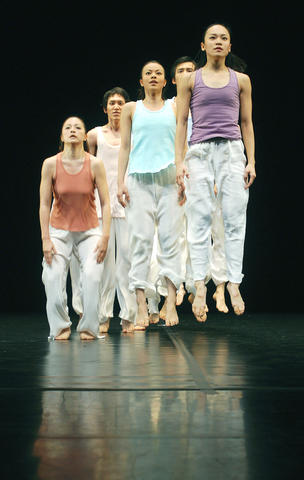
PHOTO: CHIANG YING-YING, AP
A score was not the challenge for the next choreographer, Huang Yi (黃翊); translating his vision from video and camera angles to the stage floor was. Lin said that was exactly why he wanted Huang on the program, to get him away from his computer.
Dancer/choreographer Huang, who was part of the M-Dans/Horse show last November, is in his mid-20s and is working on a master's degree from his alma mater, TNUA. His previous works have been multi-media, interactive creations that relied heavily on technology, but also helped win him a Lo Man-fei scholarship. Of course, he promptly spent that money on more gear: a video camera on a boom.
Lin said he wanted Huang to focus on the basics of dance.

PHOTO: CHIANG YING-YING, AP
"Huang Yi is an enfant terrible: small, terrible, very creative in his mind," Lin said. "I wish I had his mind. But I'm worried about the younger generation. They are too interested in their toys, in mixed media. I encouraged him to use more human bodies because everything he does requires too much money. This piece, however, is wonderful."
Working on Body, Sound (身音) had been a big change for him, Huang said on Tuesday.
"The image sought on video is very different from the image on stage. On video, I can change very fast, make changes happen very fast, make the dancers appear, disappear very fast, but on stage it is different. I have to reset, rethink the viewing angle for the stage," he said.
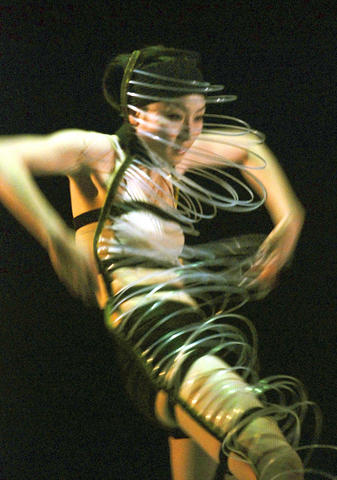
PHOTO: CHIANG YING-YING, AP
The images he has created, along with costume designer Yang Yu-teh (楊妤德) are mind-boggling. The dancers are clad in outfits that fuse bondage straps and space-age gear, a wondrous array of clinking joints, plastic tubing, thin-cut metal and who knows what else, topped off by some toy accordions. The costumes create their own soundscape with each move of the wearer's body.
Yang's costumes are so amazing that it was a shock to realize that the same mind that had matched, or perhaps fed, Huang's vision had also created the deceptively simple black tops and shorts that perfectly fit the subtle variations of Cheng's choreography in Change.
Deceptively simple could be used to describe the final piece on the program, Lin's Song of the Birds (鳥之歌), set to Spanish cellist Pablo Casals' piece of the same name (El Cant dels Ocells). Deceptively brutal, the dancers would probably say.
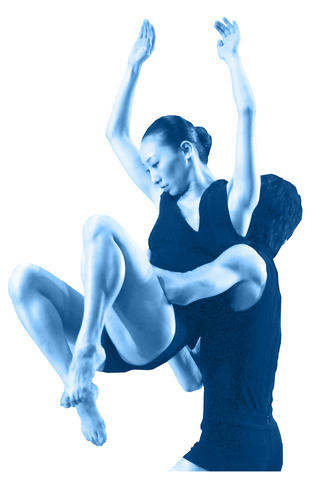
PHOTO: CHIANG YING-YING, AP
Song of the Birds is a lyrical combination of plies, demi-plies and jumps. A lot of jumping and a lot of heavy breathing.
"I want them to become stronger dancers. They have yet to fulfill their potential because they are young dancers. There are certain muscles I want them to develop, like back muscles, breathing," Lin said. "I set an obstacle for them but they did it beautifully. They survived. They acquired a new ability."
"The energy that accumulates during the performance - the breathing becomes an element of rhythm and the soundscape - it has such a great volume of energy. The audience absorbs the energy," he said. "I'm curious how people in Taipei will react. It's so simple and I never do anything simple, but this one is."
Lin will find out how people in Taipei react fairly soon. Unfortunately, many people will miss out, because tickets for the five-day Taipei run are already sold out.
The groundswell of support for Lin and the Cloud Gate companies in the wake of the fire translated into record-setting ticket sales for the Taipei shows. There were also fewer tickets than normal because Lin donated dozens of seats to the Fire Department teams that helped battle the blaze as thank-yous to the workers and their families.
Cloud Gate fans in other parts of the country are in luck, however, as tickets are still available for the weekend shows next month in Taichung, Hsinchu and Kaoshiung. Act fast because this is a show not to be missed.

Following the rollercoaster ride of 2025, next year is already shaping up to be dramatic. The ongoing constitutional crises and the nine-in-one local elections are already dominating the landscape. The constitutional crises are the ones to lose sleep over. Though much business is still being conducted, crucial items such as next year’s budget, civil servant pensions and the proposed eight-year NT$1.25 trillion (approx US$40 billion) special defense budget are still being contested. There are, however, two glimmers of hope. One is that the legally contested move by five of the eight grand justices on the Constitutional Court’s ad hoc move

Stepping off the busy through-road at Yongan Market Station, lights flashing, horns honking, I turn down a small side street and into the warm embrace of my favorite hole-in-the-wall gem, the Hoi An Banh Mi shop (越南會安麵包), red flags and yellow lanterns waving outside. “Little sister, we were wondering where you’ve been, we haven’t seen you in ages!” the owners call out with a smile. It’s been seven days. The restaurant is run by Huang Jin-chuan (黃錦泉), who is married to a local, and her little sister Eva, who helps out on weekends, having also moved to New Taipei

The Directorate-General of Budget, Accounting and Statistics (DGBAS) told legislators last week that because the Chinese Nationalist Party (KMT) and Taiwan People’s Party (TPP) are continuing to block next year’s budget from passing, the nation could lose 1.5 percent of its GDP growth next year. According to the DGBAS report, officials presented to the legislature, the 2026 budget proposal includes NT$299.2 billion in funding for new projects and funding increases for various government functions. This funding only becomes available when the legislature approves it. The DGBAS estimates that every NT$10 billion in government money not spent shaves 0.05 percent off

Dec. 29 to Jan. 4 Like the Taoist Baode Temple (保德宮) featured in last week’s column, there’s little at first glance to suggest that Taipei’s Independence Presbyterian Church in Xinbeitou (自立長老會新北投教會) has Indigenous roots. One hint is a small sign on the facade reading “Ketagalan Presbyterian Mission Association” — Ketagalan being an collective term for the Pingpu (plains Indigenous) groups who once inhabited much of northern Taiwan. Inside, a display on the back wall introduces the congregation’s founder Pan Shui-tu (潘水土), a member of the Pingpu settlement of Kipatauw, and provides information about the Ketagalan and their early involvement with Christianity. Most